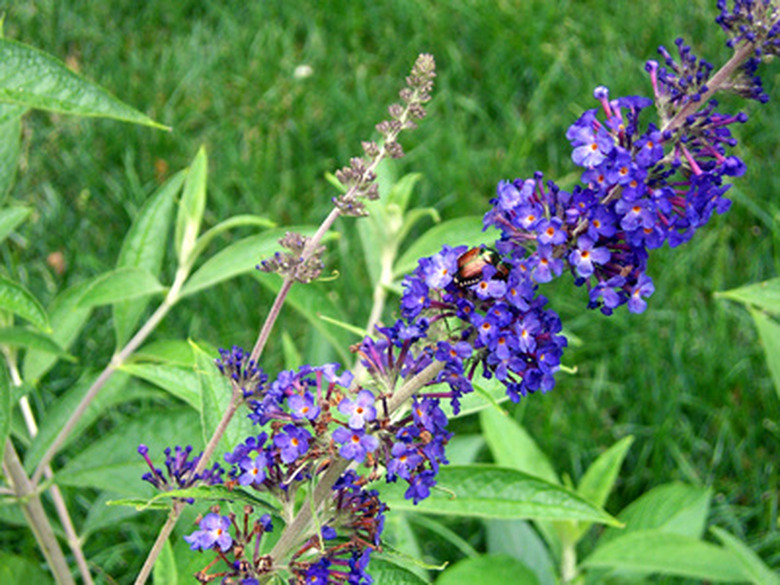How To Fertilize A Butterfly Bush
Butterfly bushes (Buddleia davidii) are lowing-growing perennial shrubs that have clusters of red, pink, purple or white flowers, which typically bloom from spring until fall. Deadheading–or pinching off–spent blooms encourages more blooms. Fertilizing your bushes once a year in the spring also encourages more blooms, as well as more lush green growth. Butterfly bushes are not heavy feeders, however, and may not need fertilizing in order to bloom and grow well.
Step 1
Determine if your butterfly bush needs fertilizer. If the soil was amended with organic matter (e.g., compost) prior to planting, and you add mulch to the planting bed each year, your bush probably does not need fertilizer. Organic matter and decomposing mulch creates fertile soil in which fertilizer is not needed.
- Butterfly bushes (Buddleia davidii) are lowing-growing perennial shrubs that have clusters of red, pink, purple or white flowers, which typically bloom from spring until fall.
- If the soil was amended with organic matter (e.g., compost) prior to planting, and you add mulch to the planting bed each year, your bush probably does not need fertilizer.
Step 2
Sprinkle a balanced granular fertilizer, such as one labeled 10-10-10, evenly around the soil of each bush. The fertilizer should not make contact with the stems or crown of the plant. Follow the dosing instructions on the label since each type of fertilizer has different strengths.
Step 3
Water the plants well with about 2 to 3 inches of water. You must always water your plants whenever you apply a granular fertilizer.
Step 4
Add a 2-inch layer of mulch, such as leaves or pine needles, around the base of each bush. The mulch will decompose over time and will help create a fertile soil bed in which you do not need to add fertilizer the next year.
- Sprinkle a balanced granular fertilizer, such as one labeled 10-10-10, evenly around the soil of each bush.
Butterfly Bush & A Butterfly Weed
A mature butterfly bush typically reaches 6 to 10 feet tall with an equal spread. Butterfly weed, on the other hand, is a perennial flower reaching only 1 to 3 feet tall. Where color is concerned, the many cultivars of butterfly bush have butterfly weed beat. White, different shades of pink, purple and blue are all commonly seen in nurseries and garden centers. Fertile, well-drained soil is an essential requirement of the butterfly weed, although butterfly bush will tolerate nearly every soil condition except for wet, particularly once it's established. Butterfly weed is tricky to transplant, but readily self-seeds — a decent patch of this colorful, native perennial is possible after a few years from just one plant. Throughout summer, butterflies, moths and other pollinators will swarm butterfly bushes in grand displays of fluttering color. As a native species, the butterfly weed is an important host plant to native wildlife.
- A mature butterfly bush typically reaches 6 to 10 feet tall with an equal spread.
- Fertile, well-drained soil is an essential requirement of the butterfly weed, although butterfly bush will tolerate nearly every soil condition except for wet, particularly once it's established.
Things Needed
- Fertilizer
- Water
- Mulch
Tip
You can also use a liquid balanced fertilizer that is usually diluted with water prior to application. Again, read the label for dosing and application instructions.
References
- Maryland Cooperative Extension: Butterfly Bush Production and Consumer Care
- University of Arkansas Division of Agriculture: Shrubs – Buddleia (Butterfly Bush)
- Yardener.com: Caring for a Butterfly Bush
- Fine Gardening: Buddleia Davidii
- Fine Gardening: Asclepias Tuberosa
- Lady Bird Johnson Wildflower Center: Asclepias Tuberosa
- Clemson Cooperative Extension: Butterfly Bush
